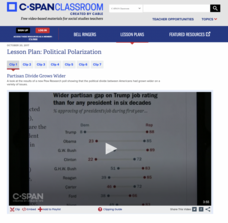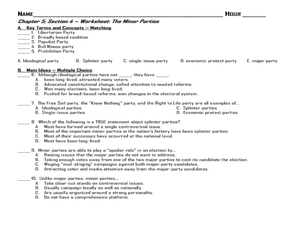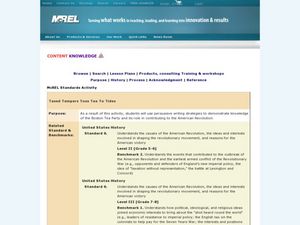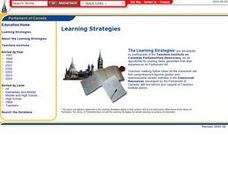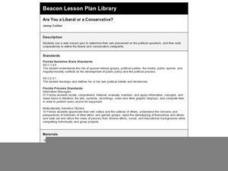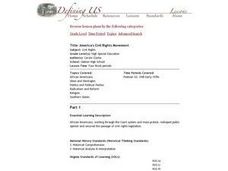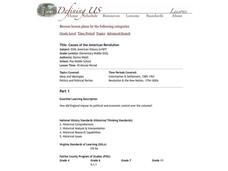Curated OER
Development of American Political Parties: The Two-Party System
Was American politics always bound to the two-party system? Learn how the two-party system developed, why third parties tend not to do so well, and all the various political parties that have emerged throughout US history. Each party is...
Curated OER
Homemade Political Parties
Use this 5-day lesson to clarify the platforms of the two major parties, comparing and contrasting against students' beliefs. Begin by looking at unlabeled summaries of both party platforms, having learners identify most with one. Groups...
C-SPAN
Political Polarization
Dive into the political breach with pupils and explore the reasons for political polarization. Using clips from C-SPAN that include discussions from reporters and scholars, class members consider what is causing the political fault lines...
Curated OER
Political Movements: Political parties
Young scholars list current federal parliamentary parties, consider the role of political parties, practice party based representation, state the relationship between parties, elections and Australian policy, and define specific...
Curated OER
Political Movement: Political Parties
Students explore politics by researching Australian government law. In this political parties lesson, students define the different active parties in Australia and their roles within the country. Students complete a word bank activity...
Curated OER
An Introduction to Immigration and the Canadian Political System
Twelfth graders take a citizenship test before learning how their own ideology fits in with current political parties. They create questions for a debate and learn the process of registering to vote.
Curated OER
The Two-Party System: Chapter 5
Guide your students' reading with this learning exercise. Included are five matching and five multiple choice questions focused on aspects of the two-party system employed in the United States. Use as a quiz, guided reading questions, or...
Curated OER
Art in Nazi Germany When Art and Politics Didn't Agree
Five lessons display the art created by Germans under the Weimar Republic. The focus of these lessons is to help learners understand the role of art in politics, government censorship, and Nazi tactics. Web links are included.
Curated OER
The Minor Parties
Help to increase the knowledge of your future (or current) voters with this quiz about minor parties. By matching various minor parties, both historical and contemporary, students can become better-informed about the entirety of American...
Curated OER
Political Ideological Spectrum
Students explore the ideologies of the American political spectrum. In this American politics lesson plan, students examine the characteristics and platforms of liberals, conservatives, libertarians, and moderates. Students...
Curated OER
Select-a-Lawmaker
Students are assigned a party faction, examine bills voted on by their party faction last year, and find a candidate with a similiar view of government.
Curated OER
Taxed Tempers Toss Tea To Tides
Engage learners in persuasive writing, research, and creative thinking. They research the series of events that led to the Boston Tea Party and create brochures that include propaganda intended to rally Patriot support or dissuade...
Curated OER
Exercising the Franchise! The Right to Vote
Students research Canadian election procedures, identify candidates and corresponding political platforms for current elections and hold mock elections. They develop a written report about a specific political party.
Curated OER
The Progressive Movement
While the Progressives never formed a political party they did develop an ideology. Provide viewers with an interesting, yet challenging presentation on the Progressive Movement that introduces key individuals and highlights key events...
Curated OER
Are You a Liberal or a Conservative?
Students take an Internet quiz that categorizes their placement on an ideological spectrum. They, in groups, define liberal and conservative.
Curated OER
McCarthysim
Eleventh graders explore and analyze the impact of the Cold War at home and how the fear of communism and nuclear war affected American life throughout the Cold War. They study what role Senator Joseph McCarthy played on American fears...
Curated OER
America's Civil Rights Movement
Eleventh graders explore, analyze and study the background to America's Civil Rights Movement through the court system, mass protest, public opinion, political cartoons and legislation. They research Rosa Parks, Brown vs. Board of...
Curated OER
Science and Politics in the Soviet Union
In this Soviet Union worksheet, students read a 2-page selection about scientific work in the country and then respond to 4 short answer questions based on the selection.
Constitutional Rights Foundation
The Election of 1912
The Election of 1912: an election with four competitive opponents. Pupils get to know the candidates with informative reading passages that provide context to the election. Then, the class engages in a debate and answers questions as one...
Curated OER
History by Heroes
Pupils role play one of the Presidents between 1877 and today. Individually, they use the internet to research the President through official documents, political cartoons and various editorials. Throughout the year, they are asked to...
Curated OER
The Origins of American Government
Students create an advertising campaign to persuade the Founding Fathers to adopt a particular political philosophy. Working in groups, they conduct research about a certain political philosophy. Students create a pitch to be made to...
Curated OER
Causes of the American Revolution
Students answer the question of: How did England impose its political and economic control over the colonies? They create a comic strip depicting the event of the Boston Massacre. Students complete a Wordstoming activity to anticipate...
Curated OER
Famous Women in the Military
Students identify and research various women and their roles in military history. They describe how modern political positions are affected by differences in ideologies and viewpoints that have developed over time. Finally, students...


